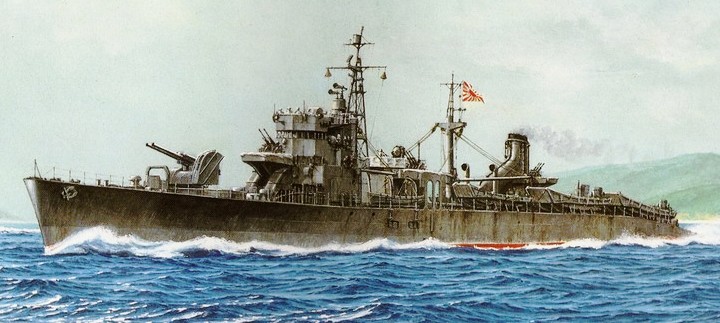Dai 1 Go-gata Yusokan
IJN No. 1 Class Fast Transport
 (No. 1 Class Fast Transport T.5 by Takeshi Yuki)
(No. 1 Class Fast Transport T.5 by Takeshi Yuki)
IJN Transport T.16:
Tabular Record of Movement
© 2014-2015 Bob Hackett and Sander Kingsepp
12 August 1944:
Yokohama. Laid down at Mitsubishi, Shipyard as Ship No. 2916,
a 1,500-ton No. 1 class landing ship.
10 October 1944:
Launched and numbered T.16.
20 October 1944:
Reserve LtCdr Kobayashi Masao is appointed Chief
Equipping Officer.
31 December 1944:
Completed. Attached to Yokosuka Naval District.
Reserve LtCdr Kobayashi Masao is the CO. Receives the order to proceed to
Yokosuka and commence working-up at Yokosuka Guard Unit.
15 January 1945:
The CO receives the order to make a supply run to
Hachijo-jima, Izu islands, Philippine Sea. The further training is canceled.
19 January 1945:
T.16 departs Yokosuka on her first supply run to
Hachijo-jima, delivers her cargo, then returns to Yokosuka.
27 January 1945:
T.16 departs Yokosuka on her next supply run to
Chichi-Jima (29 January) and Iwo Jima, delivers her cargo, then returns to
Yokosuka.
Mid-February 1945:
Departs Yokosuka on her second supply run to Iwo
Jima, carrying a cargo of weapons and ammunition.
16 February 1945:
Near Niijima, Izu Islands. T.16 is en route to Iwo
Jima when she is attacked by about 80 carrier-based Grumman F6F “Hellcat“
fighter-bombers. She suffers heavy casualties (23 KIA and 71 WIA). Her AA
batteries and steering are damaged. During the battle, her gunners claim seven
aircraft shot down. T.16 is beached at Niijima where the dead are buried, then
returns to Yokosuka.
20 February-12 March 1945:
Repaired at Yokosuka Navy Yard and put
back in service.
20 March 1945:
T.16 departs Yokosuka on her second supply run to
Hachijo-jima.
21-24 March 1945:
Arrives at Hachijo-jima, unloads her cargo, then
departs for Yokohama.
25 March 1945:
Arrives at Yokohama, proceeding to Yokosuka the next
day.
14 April 1945:
T.16 departs Yokosuka on her third supply run to
Hachijo-jima with an additional stop at Torishima, Izu islands. Makes an
overnight stop at Tateyama Bight that night.
15 April 1945:
Departs Tateyama for Hachijo-jima, arriving that same
day. Unloads 71.3 tons of cargo, departing for Torishima that same day.
16 April 1945:
Arrives at Torishima, unloads 89.4 tons of cargo.
17 April 1945:
Departs Torishima, arrives at Hachijo-jima, departing
for Tateyama the next day.
18 April 1945:
Stops at Tateyama Bight, then departs for Yokosuka,
arriving the next day.
20-30 April 1945:
Undergoes boiler repairs at Yokosuka Navy Yard.
23 April 1945:
Reserve LtCdr Nagahashi Kimata (former CO of MOKUTO)
is appointed the CO.
8 May 1945:
Departs Yokosuka on her fourth supply run to Hachijo-jima
with an additional stop at Muko-Jima (Parry Islands), Bonins. Makes an overnight
stop at Tateyama Bight that night.
9 May 1945:
Arrives at Hachijo-jima, unloads some cargo and possibly
a few passengers.
11 May 1945:
Departs Hachijo-jima for Muko-Jima.
12 May 1945:
Arrives at Muko-Jima, unloads 156.4 tons of cargo and
debarks a total of 120 passengers. Embarks new passengers from a small sailing
vessel.
13 May 1945:
Departs Muko-Jima for Yokosuka.
14 May 1945:
Returns to Yokosuka.
26 May 1945:
T.16 makes a short trip from Yokosuka to Minato, Izu
Peninsula, returning that same day.
17 June 1945:
15 miles E of Izu-Oshima Island, Izu Islands. T.16 is
damaged in an air attack and returns to Yokosuka.
20 June-15 August 1945:
Undergoes repairs at Yokosuka Navy Yard, then
laid up.
15 July 1945:
Reserve LtCdr Harada Shichiro (former navigating officer
of SUNOSAKI) is appointed the CO.
15 September 1945:
Removed from the Navy List.
26 August 1945:
Assigned to the Allied Repatriation Service as
repatriation ship. [1]
10 October 1945:
Lt Isobe Hideo (68)(former torpedo officer of I-361)
is appointed the CO.
1947~1947:
The 2nd Demobilization Ministry lends the former T.16 to
Taiyo Fisheries Co. that operates her and the former T.19 as whaling mother
ships off the Ogasawara (Bonin) Islands.
29 August 1947:
Ceded to Nationalist China at Tsingtao (Qingdao) as a
war reparation. Renamed WU YI. Re-commissioned as transport ship, but she is not
rearmed. [2]
Fall 1949:
Participates in the retreat of Kuomintang troops and
civilians from the Chinese mainland to Taiwan.
1954:
Taiwan. Decommissioned by the Republic of China and subsequently
scrapped.
Author's Note:
[1] Allied occupation forces were responsible for the return
of six million Japanese military personnel and civilians from Japan's defunct
far-flung Empire. In addition, there were over a million Korean and about 40,000
Chinese prisoners and conscript laborers and approximately 7,000 Formosans and
15,000 Ryukyu Islanders to be repatriated.
Some Allied and many former IJN warships, from aircraft carriers to
kaibokan, were used to facilitate the enormous repatriation effort. Japanese
vessels and crews were used to the fullest extent possible to conserve Allied
manpower and accelerate demobilization. Each ex-IJN ship first had to be
demilitarized; guns removed or, in the case of large warships, barrels severed,
ammunition landed, and radar and catapults removed, if fitted. Repatriation of
the Chinese on Japanese ships began early in October from Hakata, but U.S. guard
detachments had to be placed on many ships to prevent disorder because the
Japanese crews could not control the returnees.
Japanese-run repatriation centers were established at Kagoshima, Hario
near Sasebo, and Hakata near Fukuoka. Other reception centers were established
and operated at Maizuru, Shimonoseki, Sasebo, Senzaki, Kure, Uraga, Yokohama,
Moji and Hakodate. Allied line and medical personnel supervised the centers.
Incoming Japanese were sprayed with DDT, examined and inoculated for typhus and
smallpox, provided with food, and transported to their final destination in
Japan.
[2] Some sources say 30 August 1946.
Back
to Fast Transport Page
-Bob Hackett and Sander Kingsepp





